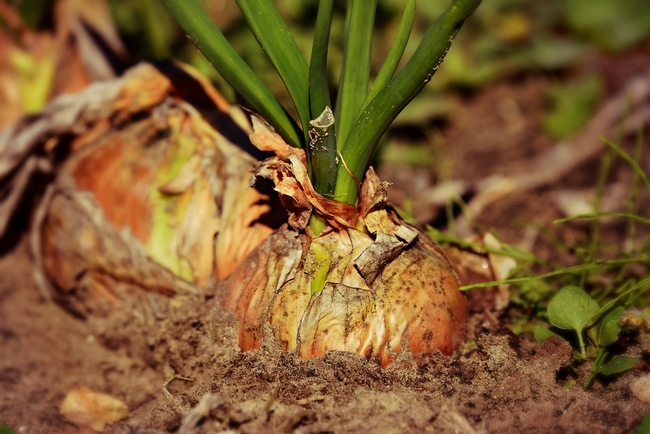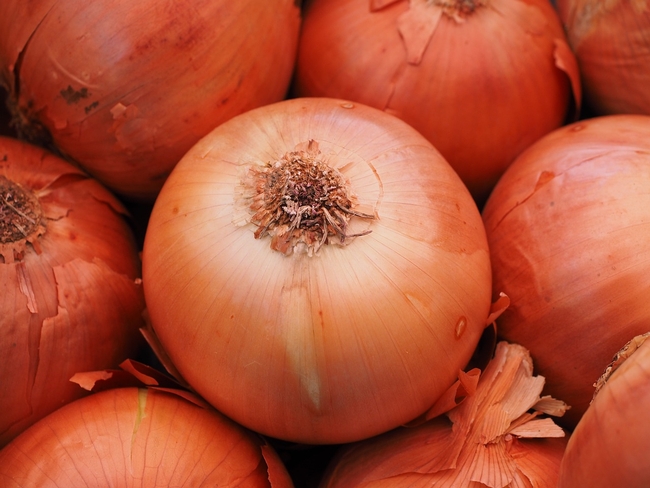During the dark and cold days of January, is there any reason to work in the garden? Add wet soil that should not be disturbed, and you have a trifecta of obstacles for planting. However, this month does present one great opportunity for home gardeners: onions.
If you want to grow nice, large bulb onions, January is prime time to set out onion seedlings. While the organized vegetable gardener will have started seeds last fall, the rest of us will head to local nurseries for onion seedlings in cell packs or order plants online to be delivered in January.
Online sources ship “bare root” seedlings in bundles of 50 or more. You can also plant from seed toward the end of the month, but you will need to allow more growing time or expect to have smaller bulbs. Napa County Master Gardeners do not recommend those bags of onion sets that resemble pearl onions; in our climate these mostly bolt rather than form bulbs.
Last fall, while the soil was still dry, I prepared one of my raised beds for alliumcrops. The alliumfamily includes onions, leeks, garlic, shallots, and chives. In November, I planted one part of the bed with leek seedlings from a local nursery and garlic sets acquired online. I reserved the rest of the bed for planting later.
To plant onion seedlings in the bed now, I will sprinkle granular fertilizer over the soil surface followed by an inch or so of compost. I use my hori hori garden knife (which is like a narrow trowel) to make a slit in the soil, set the seedlings in, then gently push the soil around the roots.
I'll set seedlings 4 to 6 inches apart, allowing room for the bulbs to form later. Depending on the rain, a sprinkling of water from an adjustable hose nozzle completes the planting. I also set up drip irrigation at the time of planting. When the dry season starts, I water the onions once or twice a week.
Onions take a long time to form nice bulbs. Seedlings planted now will mature in late June or early July, even later if you are starting from seed. You will know when they are ready as the bulbs pop up from the ground and the leaves fall over.
When it gets close to harvest time, I stop watering to get the bulbs to dry out a bit. According to the California Master Gardener Handbook, you should not dig onions up too soon if you plan to store them. Note that varieties vary in their storage potential.
Many onion varieties are sensitive to day length. Short-day onions start to bulb when the day is 12 to 13 hours long. Long-day onions need 14 to 16 hours of daylight, and intermediate types require 13 to 14 hours.
In Napa Valley, we hit the 14-hour mark around May 6. Our longest day is June 21, the summer solstice, when we get nearly 15 hours of daylight. In our climate the intermediate-day varieties tend to produce the best bulbs. Seedlings planted in January will have 4 to 5 months to grow before the day length signals them to form bulbs.
Some newer varieties are considered day neutral. These varieties tend to be better for fresh use than for storage.
Frosty weather signals onion plants to bloom if they are larger in diameter than a pencil. As a consequence, seedlings planted in October might not form bulbs if January frosts induce them to bloom. Gardeners call this process vernalization. When small onion seedlings are planted in January, they usually are not affected.
Last January I planted approximately 80 seedlings of intermediate-day onions. They were a mix of three varieties: white Super Star, yellow Candy, and Red Candy Apple. Very few bolted and I had a bumper crop in June.
Onions don't last forever in storage. Some of mine sprouted or got soft before I could use them, but the last four onions are on my kitchen counter now. I consider that a successful result and I am looking to repeat it this year.
Workshop: Join UC Master Gardeners of Napa County for “Pruning Deciduous Fruit Trees” on Saturday, January 27, from 10 a.m. to noon at Las Flores Learning Garden, 4300 Linda Vista Avenue, Napa. Learn the whys and hows of winter pruning, techniques, and tool care. Workshop is indoors but dress warmly for outdoor activities, weather permitting. Space is limited. Register here.
Library Talk: Join UC Master Gardeners of Napa County for “Growing Lettuce Year-Round in Napa County” on Thursday, February 1, from 7 pm to 8 pm, via Zoom. Learn how a seasonal field trial revealed lessons about growing lettuce in Napa County. Register to receive the Zoom link.
Help Desk: The Master Gardener Help Desk is available to answer your garden questions on Mondays and Fridays from 10 a.m. until 1 p.m. at the University of California Cooperative Extension Office, 1710 Soscol Avenue, Suite 4, Napa. Or send your questions to mastergardeners@countyofnapa.org. Include your name, address, phone number and a brief description.
Attached Images:

